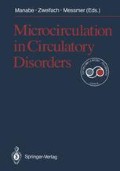Abstract
The mechanism of stress-induced acute gastric mucosal lesions (AGML) has been investigated for some time. We have reported that in hemorrhagic shock, the decrease of gastric mucosal blood flow, volume, and its oxygenation precedes the gastric ulceration which appears usually after infusion of blood or at the recovery stage in rats and humans. It is believed that the microcirculatory disturbance resulting in hypoxia in the gastric mucosa produced an incipient mucosal state for ulcerogenesis and that in this hydrochloric acid and histamine played an aggressive role. The precise mechanism leading to cell death after ischemia is, however, obscure. In this symposium, we presented a movie film which showed the process of gastric mucosal microcirculatory disturbance and bleeding caused by indomethacin, leukotriene C4 (LTC4), platelet-activating factor (PAF) and HCI and also reported the role of chemical and ionic factors in the repefusion state in the etiology of gastric ulceration.
Access this chapter
Tax calculation will be finalised at checkout
Purchases are for personal use only
Preview
Unable to display preview. Download preview PDF.
References
Sato N, Kamada T, Shichiri M, Kawano S, Abe H, Hagihara B (1979) Measurement of hemoperfusion and oxygen sufficiency in gastric mucosa in vivo. Gastroenterology 76: 814–819
Kamada T, Sato N, Kawano S, Fusamoto H, Abe H (1982) Gastric mucosal hemodynamics after thermal or head injury. Gastroenterology 83: 535–540
Sato N, Kawano S, Kamada T, Takeda M (1986) Hemodynamics of the gastric mucosa and gastric ulceration in rats and in patients with gastric ulcer. Dig Dis Sci 31: 35S–41S
Hase T, Moss BJ (1973) Microvascular changes of gastric mucosa in the development of stress ulcer in rats. Gastroenterology 65: 224–234
Szabo S, Trier JS, Brown A, Schnoor J (1985) Early vascular injury and increased vascular permiability in gastric mucosal injury caused by ethanol in the rat. Gastroenterology 88: 228–236
Itoh M, Guth PH (1985) Role of oxygen-derived free radicals in hemorrhagic shockinduced gastric lesions in the rat. Gastroenterology 88: 1162–1167
Author information
Authors and Affiliations
Editor information
Editors and Affiliations
Rights and permissions
Copyright information
© 1988 Springer-Verlag Tokyo
About this chapter
Cite this chapter
Kawano, S., Sato, N., Tsuji, S., Kamada, T., Satoh, H., Inatomi, N. (1988). Gastric Microcirculatory Changes Associated with Physicochemical and Ionic Mediators. In: Manabe, H., Zweifach, B.W., Messmer, K. (eds) Microcirculation in Circulatory Disorders. Springer, Tokyo. https://doi.org/10.1007/978-4-431-68078-9_20
Download citation
DOI: https://doi.org/10.1007/978-4-431-68078-9_20
Publisher Name: Springer, Tokyo
Print ISBN: 978-4-431-68080-2
Online ISBN: 978-4-431-68078-9
eBook Packages: Springer Book Archive

